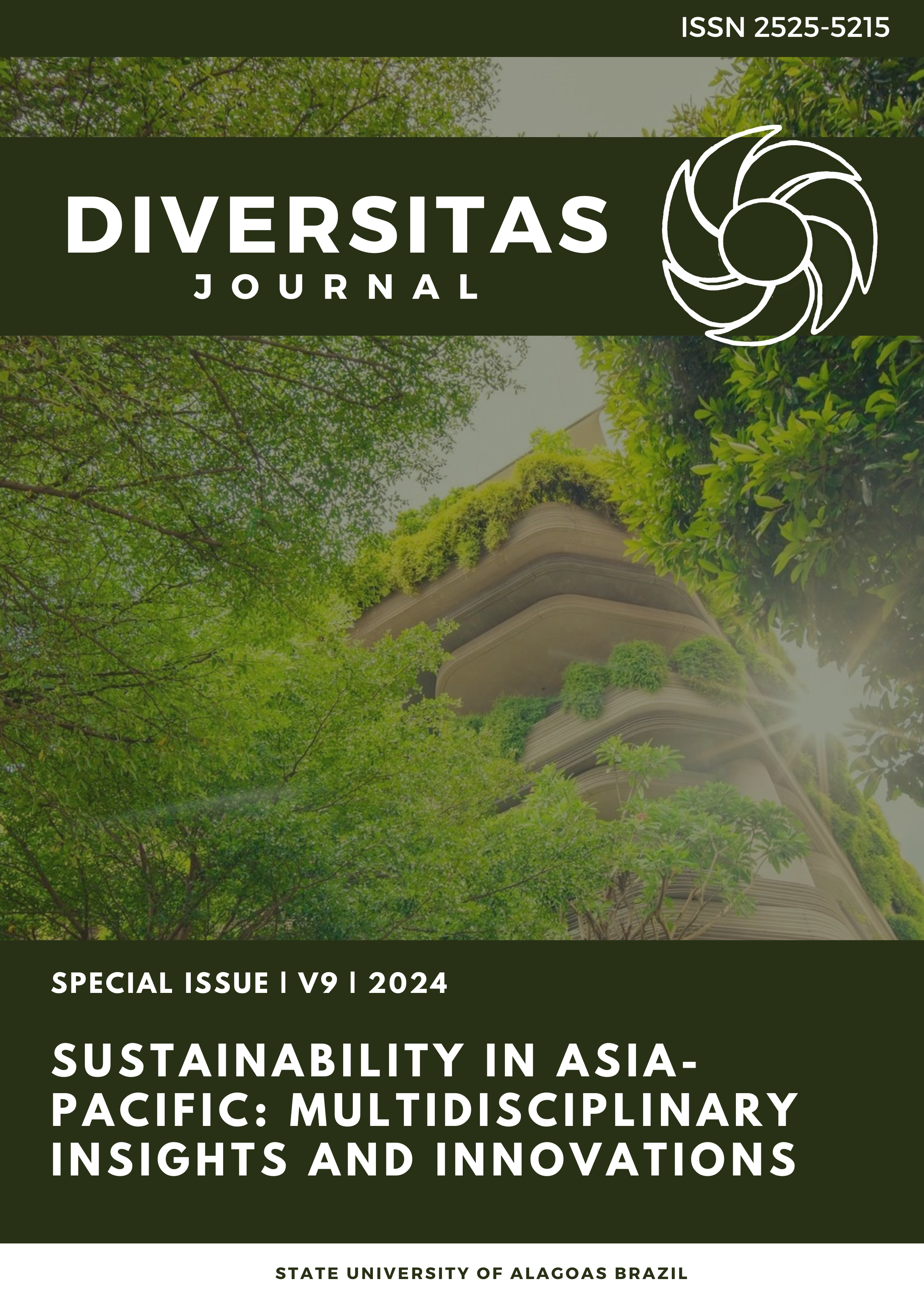Desempenho de postura e taxa de eclodibilidade de frango nativo Bolinao fiel ao tipo no local de demonstração ASIST Lagangilang, Abra, Filipinas
DOI:
https://doi.org/10.48017/dj.v9i1_Special.2877Palavras-chave:
Produção de ovos, galinha, galo, condiçãoResumo
Este estudo foi conduzido para avaliar o desempenho da produção entre Abra e Bolinao, origem Pangasinan de frango nativo Bolinao True-to-type no Instituto Estadual de Ciências e Tecnologia de Abra ASIST (demo-site) em Lagangilang, Abra. O estudo foi realizado durante oito meses, de agosto de 2022 a março de 2023. A produção média mensal de ovos varia de 7 a 14, com média de 10,27 no grupo A (origem Abra), enquanto 5 a 12 ovos por galinha no grupo B (origem Bolinao). ) com média de 8,93, a produção de ovos no galinheiro (HHEP) é maior no grupo A (34,13%) em comparação ao grupo B com 29,65%. A massa média dos ovos é discretamente maior também no grupo A (14,54%), em comparação ao grupo B com 13,10%, porém, um teste T significativo (0,05) maior peso dos ovos é observado no grupo B (44,10 gramas), em comparação ao grupo A (42,46 gramas), enquanto na conversão alimentar (CA) melhor eficiência é observada no grupo B (2,72) que é significativa no nível 0,05, em comparação ao grupo A (2,83). Em termos de taxa de eclodibilidade, o grupo A teve melhor desempenho (47,83%), comparado ao grupo B com 41,01%, enquanto o peso dos pintinhos ao eclodir observou resultado insignificante entre os dois grupos com média de 27,49 gramas no grupo A e 27,09 gramas. no grupo B respectivamente
Métricas
Referências
Aberra Melesse, Wodmeneh Esatu, Tadelle Dessie, & Tadelle Dessie. (2022). Production performance and egg quality evaluation of indigenous chickens across different agro-ecologies of Southern Ethiopia. Veterinary Integrative Sciences, 20(1), 133-145. https://www.researchgate.net/deref/https%3A%2F%2Fdoi.org%2F10.1080%2F26895293.2021.2024894
Al Tech. (2018). 15 management tips for better poultry performance. https://www.alltech.com/blog/15-management-tips-better-poultry-performance-potential
Brosas, A. (2022). Lists of Philippine Native Chicken Breeds. Sustainable Agriculture. Retrieved from: https://www.agraryo.com
Cabarles Jr, J. C. (2013). Production potentials of native chickens (Gallus gallus domesticus L.) of Western Visayas, Philippines. Trop Anim Health Prod, 45(2), 405-410. https://pubmed.ncbi.nlm.nih.gov/23011671/
Habte, M., Ameha, N., & Demeke, S. (2013). Production performance of local and exotic breeds of chicken at rural household level in Nole Kabba Woreda, Western Wollega, Ethiopia. African Journal of Agricultural Research, 8(11), 1014-1021. http://www.academicjournals.org/AJAR
Jacob, J. P., Wilson, H. R., Miles, R. D., Butcher, G. D., & Mather, F. B. (2018). Factors Affecting Egg Production in Backyard Chicken Flocks. Department of Animal Sciences, UF/IFAS Extension. https://edis.ifas.ufl.edu
Lambio, A. A. (2018). Native Chicken, Production and Management Practices in the Philippines. College of Agriculture and Food Science, University of the Philippines, Los Banos, Laguna, Philippines. ISBN 978-621-95678-6-0
Lopez, R., Lambio, A. L., Vega, R. S. A., & Pauline, A. (2014). Management practices of native chicken (Gallus gallus domesticus Linn.) production in Palawan, Philippines. Phillip J Vet Anim Sci, 40(2), 109–112. https://www.researchgate.net/publication/349548464_MANAGEMENT_PRACTICES_OF_NATIVE_CHICKEN_Gallus_gallus_domesticus_Linn_PRODUCTION_IN_PALAWAN_PHILIPPINES_MANAGEMENT_PRACTICES_OF_NATIVE_CHICKEN_Gallus_gallus_domesticus_Linn_PRODUCTION_IN_PALAWAN_PHILIP
Nour, M. A., El-Hindawy, M. M., Abou-Kassem, D. E., Ashour, E. A., Abd El-Hack, M. E., Mahgoub, S., Aboelenin, S. M., Soliman, M. M., El-Tarabily, K. A., & Abdel-Moneim, A. E. (2021). Productive performance, fertility and hatchability, blood indices and gut microbial load in laying quails as affected by two types of probiotic bacteria. Saudi J Biol Sci, 28(11), 6544–6555. https://doi.org/10.1016/j.sjbs.2021.07.030
Ogbu, O. C., & Oguike, M. A. (2019). Hatchability of Fertile Eggs in Poultry Industry. Journal of Agriculture and Sustainability, 12(1), 107-123. https://core.ac.uk/reader/229605480
Santiago, R. C. (2018). Native Chicken Farming. Agriculture Magazine, November 2018. Retrieved from: https://www.agriculture.com.ph/2018/11/21/native-chicken-farming/
Santiago, J. C. Q., Achuela, H. H., Batara, D. C. R., Gann, P. J. I., Vingua, E. C., Cacho, R. C. C., Agcaoili, M. J. T. T., Aguinaldo, R. S., Calventas, R. D. Q., Palafox, L. A. G., Balneg, B. B., & Calpito, M. C. H. (2021). Phenotypic and Molecular Diversity of Native Chicken Genetic Groups in the Philippines. Advances in Social Science, Education and Humanities Research, 630. https://www.atlantis-press.com/article/125968187.pdf
Sisay, F. (2015). Effects of feeding processed kidney bean meal (Phaseolus vulgaris) instead of soybean meal on qualities of eggs of white leghorn hens. International Journal of Agricultural Research, 4(3), 049-056. https://www.researchgate.net/publication/273886122_Effects_of_feeding_processed_kidney_bean_meal_Phaseolus_vulgaris_instead_of_soybean_meal_on_qualities_of_eggs_of_white_leghorn_hens
The Poultry Care. (2021). The Broiler and Layer Chicken Vaccination Schedule. https://poultry.care
Yan, G. (2020). Farming heritage chicken breeds of the Philippines. The Poultry Site. Retrieved from: https://www.thepoultrysite.com
Yizengaw, M., Kebede, E., & Getachew, A. (2022). Review of chicken productive and reproductive performance and its challenges in Ethiopia. All Life, 15(1). https://www.researchgate.net/deref/https%3A%2F%2Fdoi.org%2F10.1080%2F26895293.2021.2024894
Yousif, M. S. N. A. B. (2020). Comparative study of hatchability and fertility rate among local quails. The Iraqi Journal of Agricultural Sciences, 51(3), 746. https://www.researchgate.net/publication/349548464_MANAGEMENT_PRACTICES_OF_NATIVE_CHICKEN_Gallus_gallus_domesticus_Linn_PRODUCTION_IN_PALAWAN_PHILIPPINES_MANAGEMENT_PRACTICES_OF_NATIVE_CHICKEN_Gallus_gallus_domesticus_Linn_PRODUCTION_IN_PALAWAN_PHILIP
Downloads
Publicado
Como Citar
Edição
Seção
Licença
Copyright (c) 2024 Dina B. Tadeo

Este trabalho está licenciado sob uma licença Creative Commons Attribution 4.0 International License.
O periodico Diversitas Journal expressa que os artigos são de unica responsabilidade dos Autores, conhecedores da legislação Brasileira e internacional. Os artigos são revisados pelos pares e devem ter o cuidado de avisar da possível incidencia de plagiarismo. Contudo o plagio é uma ação incontestavel dos autores. A Diversitas Journal não publicará artigos com indicios de Plagiarismos. Artigos com plagios serão tratados em conformidade com os procedimentos de plagiarismo COPE.
A violação dos direitos autorais constitui crime, previsto no artigo 184, do Código Penal Brasileiro:
“Art. 184 Violar direitos de autor e os que lhe são conexos: Pena – detenção, de 3 (três) meses a 1 (um) ano, ou multa. § 1o Se a violação consistir em reprodução total ou parcial, com intuito de lucro direto ou indireto, por qualquer meio ou processo, de obra intelectual, interpretação, execução ou fonograma, sem autorização expressa do autor, do artista intérprete ou executante, do produtor, conforme o caso, ou de quem os represente: Pena – reclusão, de 2 (dois) a 4 (quatro) anos, e multa.”


















